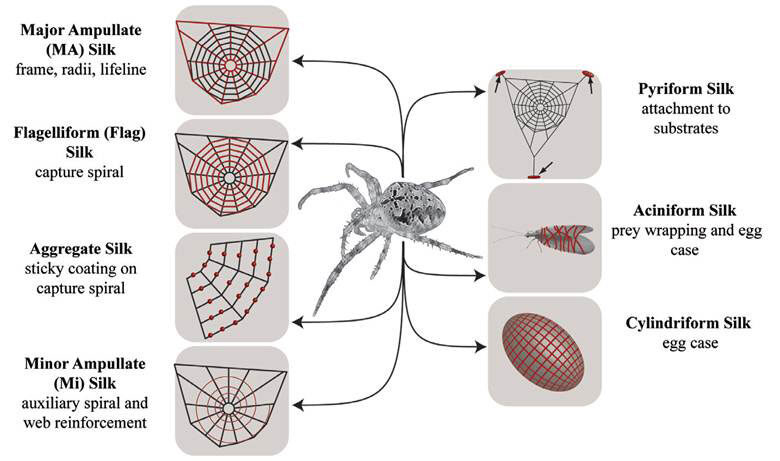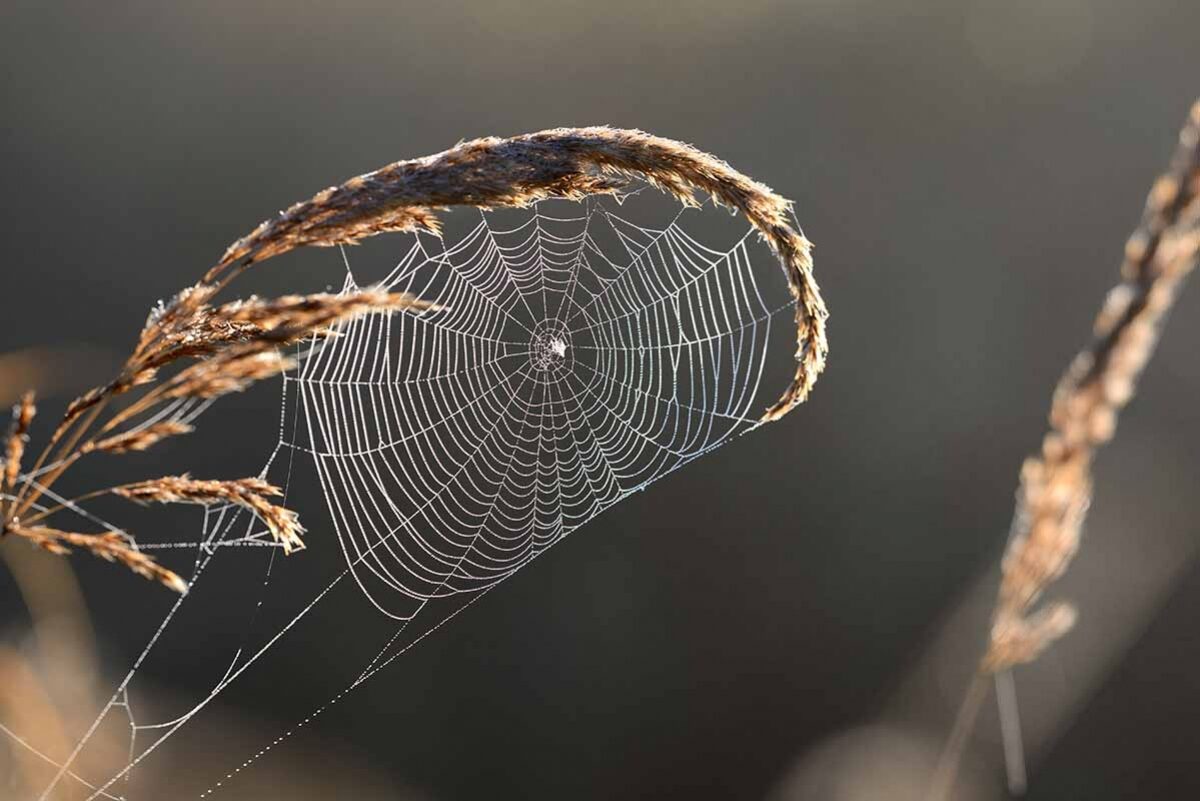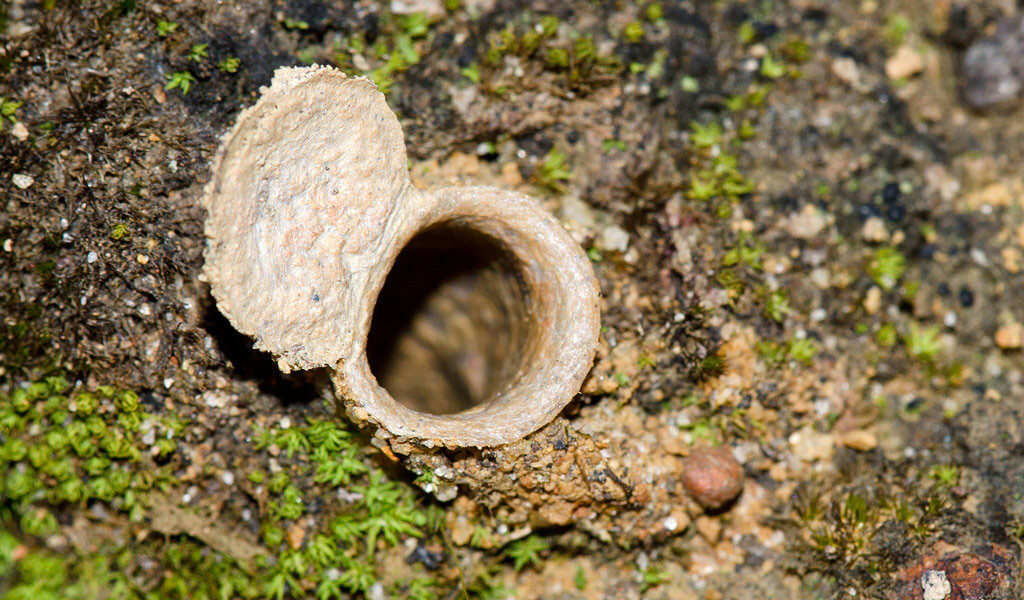"What's miraculous about a spider's web?" said Mrs. Arable. "I don't see why you say a web is a miracle — it's just a web."Spiders are another of nature's master engineers. About half of known spider species (order Araneae) construct webs made of silk. Spiders can make different types of silk, depending upon its function. For example, the golden orb-weaver spider has seven kinds of silk glands, with six spinnerets.1 Some is used for spinning webs, of course, but other types are used for wrapping prey and encasing eggs. Silk can be stronger than steel of the same thickness, can stretch more than rubber, and is stickier than most tape.2 The Goulds describe silk as "easily the most remarkable building material on the planet, and it has one source: arthropods."3 Despite great effort, humans have yet to produce anything functionally equivalent to silk. Through genetic engineering, attempts have been made to duplicate it without success. The main challenge is replicating the sophisticated and information-rich protein molecules found in the silk produced by spiders and other silk-producing arthropods such as silkworms — proteins that are nearly double the size of average human proteins.4Smaller proteins do not have the strength or flexibility of spider silk. Given the advanced genetic and manufacturing technologies available today, it is remarkable that spider silk still cannot be duplicated. This illustrates just how advanced the engineering design of spider silk is.
"Ever try to spin one?" asked Dr. Dorian. — E. B. White, Charlotte's Web
A Typical Garden Spiderweb
Orb webs are the most common and familiar types of spiderwebs. A typical garden spiderweb is made of 65 to 195 feet of silk.5 The webs consist of sticky "catching threads"; radial "spokes" for holding the sticky threads; "bridge threads" that act as guy-lines for holding the web up; "signal threads" that inform the spider through vibrations sensed in the legs that prey is in the web; and "drag lines" for access into the web from her home.6 The silks employed in the different uses are each unique, being constructed of different combinations of proteins. The types include "slinky" for stretchiness, "zipper" for flexibility, and "lego" for toughness.7 Construction of the web is a purposeful, goal-driven activity. This becomes particularly obvious as one observes the process in videos available on the Internet.8

Trapdoors, Collars, and Tubes
Another source of difference is function. When we think of spiderwebs, we tend to imagine the kind most commonly encountered — the netlike webs spread between trees or attic rafters or walls. But there are various other types, including ones that function as trapdoors into spider burrows, collars that extend out from burrows, and webs that function as tubes on tree bark that can also have hinged doors.10
I mentioned signal threads above. They tell a spider that prey is present on the web, but they convey a lot more than just that. Spiders are able to determine both the angle and distance of the prey from the center of the web. They are able to determine the prey location using the same basic technique we use to determine the location of the source of sound. Humans use the difference in intensity of sound received by our ears to estimate the relative location. Spiders do something similar based on the intensity of vibrations received, in their case sensed through eight legs.11 Obviously the algorithm used in processing information from eight sensors is much more complicated than just the two sensors that humans have. And that's only the half of it. Experiments have demonstrated that spiders can store the coordinates for the locations of at least three different prey trapped in the web.12
In Search of Evolutionary Explanations
Providing credible evolutionary explanations for the origin of silk and web design has proven problematic. Several theories have been proposed for the origin of both, but none have been generally accepted.13 Biologist and spider specialist William Shear concedes that "a functional explanation for the origins of silk and the spinning habit may be impossible to achieve."14 One complicating factor is that the webs of some spiders that are more distantly related are nearly identical. Shear writes, "It appears probable that several web types are the product of convergent evolution — that is, that the same web has evolved in unrelated species that have adapted to similar environmental circumstances."15 But as I will argue in Chapter 6, that is an unconvincing explanation for the origin of complex programmed behaviors.
A more fundamental challenge for those seeking to provide a detailed, causally credible explanation for the origin of silk and spiderweb architecture is the number of genes involved in producing silk, and the complex genomes of spiders.16 After decades of failed attempts to provide a causally adequate explanation, one can be forgiven for concluding that we have no compelling reason to assume that a step-by-step evolutionary pathway to such an information-rich substrate actually exists. And as we will discuss later, there are now some positive reasons to consider that such information-rich systems have for their source something other than a purely blind material process. Here, suffice it to say that the behaviors and functions associated with both silk and web spinning exhibit many characteristics of human engineering, and engineering of a very high order.
An excerpt from the newly released book, Animal Algorithms: Evolution and the Mysterious Origin of Ingenious Instincts, from Discovery Institute Press.Notes
- Elizabeth Pennisi, "Untangling Spider Biology," Science 358 (October 2017): 292.
- Barbara Taylor, Jen Green, and John Farndon, The Big Bug Book (London: Hermes House, 2007), 22.
- Gould and Gould, Animal Architects, 19.
- Robert Service notes that "mass-produced, superstrong fibers remain out of reach." Robert F. Service, "Silken Promises," Science 358, no. 6361 (October 2017): 293-294.
- Taylor, Green, and Farndon, The Big Bug Book, 24.
- Heinrich, The Homing Instinct, 183.
- Valerie Altounian, Elizabeth Pennisi, and Robert F. Service, "A Spinner's Secrets," Science 358 (October 2017): 292, https://doi.org/10.1126/science.358.6361.292.
- Two such videos are Deep Look's "Is a Spider's Web a Part of Its Mind?," (Video here); and BBC Earth's "Beautiful Spider Web Build Time-Lapse," (Video here).
- Gould and Gould, Animal Architects, 52-53.
- William Shear, "Untangling the Evolution of the Web," in Exploring Animal Behavior, eds. Sherman and Alcock, 149.
- Gould and Gould, Animal Architects, 50. The Goulds further explain, "The vibrations induced by struggling insects are transmitted along the slack and sticky spiral of catching threads to the taut radii, and thence to the center. The spider compares the strength of vibrations between radii to interpolate the angle of the prey from the center. In theory, the spider should simply rush out along the closest radius until it encounters the insect. However, when vibrations are induced experimentally, the spider nevertheless stops at about the right distance out from the center of the web."
- Heinrich, The Homing Instinct, 50.
- Shear, "Untangling the Evolution of the Web," 148-158.
- Shear, "Untangling the Evolution of the Web," 151.
- Shear, "Untangling the Evolution of the Web," 153-154.
- Pennisi, "Untangling Spider Biology," 288-291.





Mankind is surrounded by clues to our ancient past, one of great technologies.
The spiders Web is inviting you to explore that world.